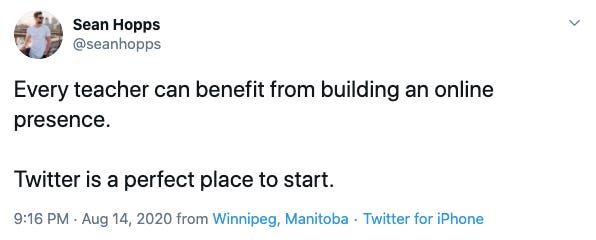It’s important to share your successes and failures in the classroom with others.
You get a chance to reflect on your lesson while simultaneously helping others with their own teaching practice.
Many of us don’t participate in this practice. The reasons can vary, but the more we normalize sharing experiences and ideas, the better our classrooms can become.

Since putting more focus on Twitter, I’ve been exposed to a number of teachers who’ve helped shape my teaching practices for the better. It’s now my favourite platform for developing a strong professional learning community.
Alongside my Twitter account, my goal with this newsletter is to do the same for you. If there’s anything more I can do, hit the reply button and let me know.
Onto this week’s teaching ideas.
1. What Makes Online Courses Engaging?

Shifting from in-class to online learning was a challenge. Neither teachers nor students were prepared for it, and many of us just scraped together a plan that we thought would work.
I’ve spent time this summer learning what makes an online course engaging for adult learners. David Perell and Tiago Forte are two of the best to do it, and Julia’s thread on what makes their courses engaging is beneficial for any teacher.
We are starting in person in a few weeks, but if the time comes where we shift to online learning, I will be implementing a lot of what she shared.
Discussion Points:
What did you like/dislike about learning online in the spring? What could your teachers have done differently to make it more engaging for you?
Do you believe learning online is the future of education? Why/why not?
Would you prefer an education system that allows you to hand-select the courses you take rather than being given mandatory and select electives to reach graduation status? What if those courses are entirely online?
Assignment Idea:
Regardless if we are starting in person or online, I think it’s important to include your students in the planning for online learning.
Students will work individually or in groups to identify what would enhance their online learning experience. Some of the topics they can narrow their focus on include:
Synchronous versus asynchronous learning
Learning content through live sessions or pre-recorded videos
Zoom/Meet/Teams live sessions being used for teaching or discussion/collaboration
Ways to assess that give the student more choice
You could format this as an assignment or shape your student’s entire learning experience. I plan to do the latter.
2. Amazon Anchor Stores

With malls expecting a 20% decline in cash flow combined that with online sales boosting in 2020, property managers are starting to get creative.
Turning department stores into Amazon fulfillment centres would give malls a tenant without having to cater to foot traffic.
It’s important to share retail evolution with students. Malls used to be a hot spot for teenagers, but with how convenient it is to order products online, they’ve become less desirable.
In fact, many of our current students probably don’t view the mall as a place they want to go.
Discussion Points:
How would Amazon fulfillment centres impact the physical mall? How would it impact online shopping consumers in that area?
How can shopping malls be revived once the pandemic has ended?
Do you see a time when brick-and-mortar retail no longer exists? What impact would that have on our local and national economy?
Assignment Idea:
To teach students why online shopping has become more popular, it’s important for them to understand the reasons why.
Students will conduct market research to learn the reasons why consumers decide to shop from a physical or virtual space.
The questions students will include can vary, but you can push them towards topics like:
Cash versus credit card (including the trust of using credit cards online)
How important trying something before you buy is
Customer service
Cleanliness in a store versus pre-packaged items being shipped
Importance of time between purchase and receiving the item
Types of products that consumers won’t purchase online
3. Monetizing Newsletters

Making money online is becoming more appealing for entrepreneurs. Email newsletters (like this one) are becoming one of the ways creators are accomplishing that.
Marie Dollé's analysis of making money through newsletters is something we should expose students to. Many of them possess thoughts and ideas that they’d like to share but don’t have an audience within their school. The internet allows them (and us) to share those views with others who have the same interests.
I plan to get my students to develop a newsletter this year. Giving them the knowledge behind the creation is great. Showing them how to monetize it is even better.
Discussion Points:
Could newsletter publications replace print media?
What would a newsletter need to include in order for you to pay money for it?
What advantages does a direct-to-inbox writing approach have over other forms like blogs, podcasts, or video?
Assignment Idea:
Students will develop a plan for a paid newsletter.
The newsletter the students will develop won’t have a free option. They will be responsible for convincing others to sign up for a paid option without any previous examples of writing.
In order to accomplish this, students will develop a slide deck containing:
What their newsletter is about
What content will be included
What pricing structure the newsletter will have
The “why” for the subscriber
I plan to give my students a “budget” to spend on newsletters. Once they’ve heard all the pitches, each student will choose which newsletters they want to subscribe to based on their budget and pricing structure of each.
Once results have come in, we can analyze why certain newsletters were viewed as a higher value than others.
4. Nineteen Eighty-Fortnite
Don’t waste your time talking about Fortnite. Students know more about it than we do.
Instead, talk to them about the implications of Apple’s profit-splitting policy and how that impacts all creators.
I didn’t realize how much money the App Store made for Apple. It has made me reconsider how I make purchases through my phone. I’m curious if students have the same thought.
Discussion Points:
How important is having Fortnite on the App Store for Epic Games? Do you believe that they can continue to be as popular without Apple users?
Why can Apple demand 30% of all in-app sales?
What are the long-term implications for Apple if more companies decide they don’t want to pay those fees anymore?
Assignment Idea:
Have students choose an app they use regularly that offers in-app purchases.
In order to comprehend the amount of money Apple makes off of this policy, get each student to research the annual in-app sales for that company.
Combine the totals of all the apps students research to find out how much Apple has earned from that.
This can go into a good discussion over the policy and the advantages/disadvantages of it. You can also discuss the market cap Apple has on the smartphone industry, which gives it the power to enforce this policy without much backlash.
5. Instagram Reels vs. TikTok

Competition is an important business concept. Without it, pricing would be astronomical and many of us wouldn’t be able to afford the things we want.
Apps operate the same way. Without competition, companies could become stagnate and never push the envelope for what that app can offer.
A discussion surrounding Instagram Reels should focus on that. If anything, it’ll force TikTok and Instagram to continue to innovate those portions of their apps to gain a higher market share similar to many platforms mimicking Snapchat’s story feature.
Discussion Points:
What advantage does Instagram hold over TikTok with their Reels feature?
TikTok’s algorithm benefits the creator’s ability to go viral. How can Instagram combat that with their current engagement-focused algorithm?
Will Reels cause users to abandon TikTok with a looming app ban in the United States? Why/why not?
Assignment Idea:
Split the class into small groups and give them each a topic and platform. Try to have two groups that have the same topic, but one will use Reels while the other uses TikTok.
Challenge students to create an informational or tutorial-based video surrounding that topic utilizing the features within the app. This will force them to learn more about a topic alongside the app.
Students can then present their videos to the class to break down each platform’s capabilities and persuasiveness. Students can also reflect on their experiences using each.
To take it one step further, students could upload their videos on public accounts to see how many views they get over a period of time.
I appreciate it if you’ve made it this far. If there’s anything more I can do for you with this newsletter, please hit the reply button and let me know. I want to evolve Teach Business Today in ways that benefit you and your students.
If you find value in these articles and think other educators can benefit from it, please consider sharing it.
Finally, if you’re finding this email going to your promotions or spam folder, consider adding me to your email list so you don’t miss future emails.
Take care! Until next week,
Sean



